Looking for Harriet Lowenhjelm
One crisp, fall morning, in a waiting room at Kristianstad hospital, I pick up a magazine from the stack. Perusing it, my eyes fall on a photograph..
-
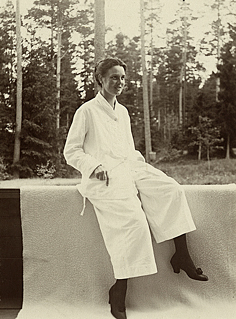 Photo of Harriet Löwenhjelm at Romanäs sanatorium by fellow patient Ulf von Konow, 1917.
Photo of Harriet Löwenhjelm at Romanäs sanatorium by fellow patient Ulf von Konow, 1917. -
-
One crisp, fall morning, in a waiting room at Kristianstad hospital, I pick up a magazine from the stack. Perusing it, my eyes fall on a photograph of a young woman in white pajamas, seated on a bed. The photo is an old black and white one—I make out tall, dark trees in the back. It’s a bizarre photograph to find in this sort of glossy magazine. Where was it taken? Who took it? Why do those trees look so ominous? And who is she, the girl with the oval face, who looks straight into the camera?
-
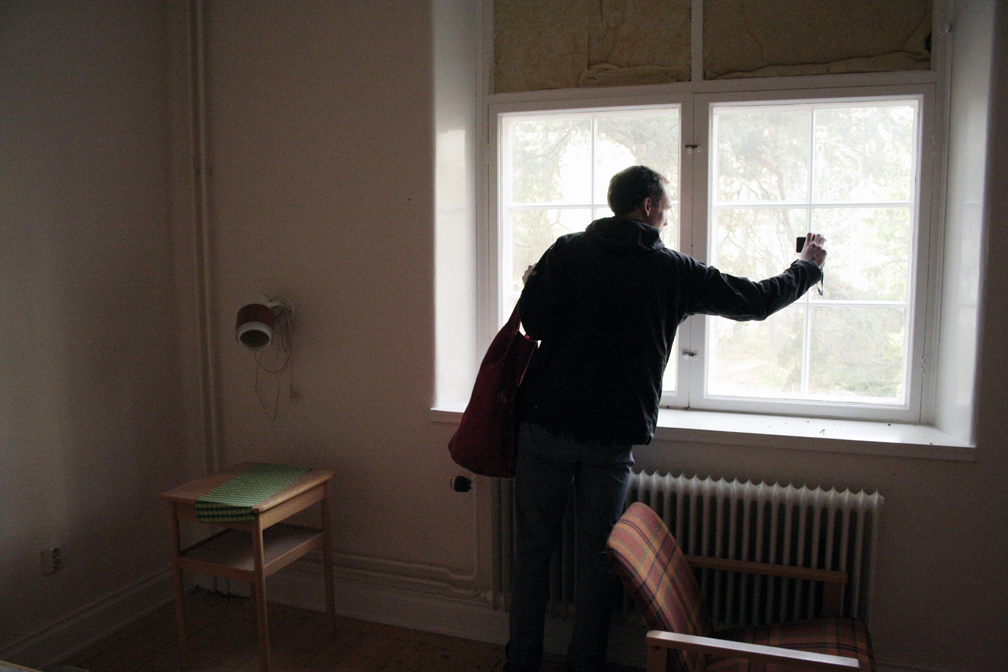 Mattias Käck taking a clandestine photo of the view in "Room 18."
Mattias Käck taking a clandestine photo of the view in "Room 18." -
-
Beatrice-Aurore
In Stockholm town at Kornhamnstorg
in Hallbeck’s secondhand bookstore
I bought an ancient dream-book once
composed in days of yore. -
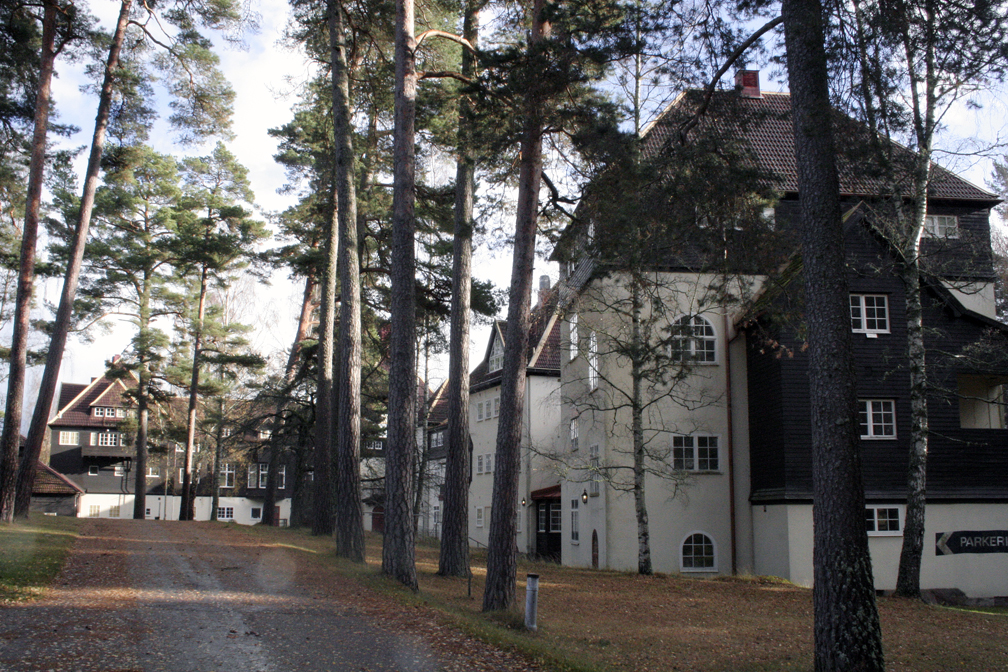 Romanäs sanatorium, fall 2013. Photo: Eva Stenskär
Romanäs sanatorium, fall 2013. Photo: Eva Stenskär -
Then I lay dreaming all last night
of Beatrice-Aurore.
She was a one time love of mine
whom I lost long before. -
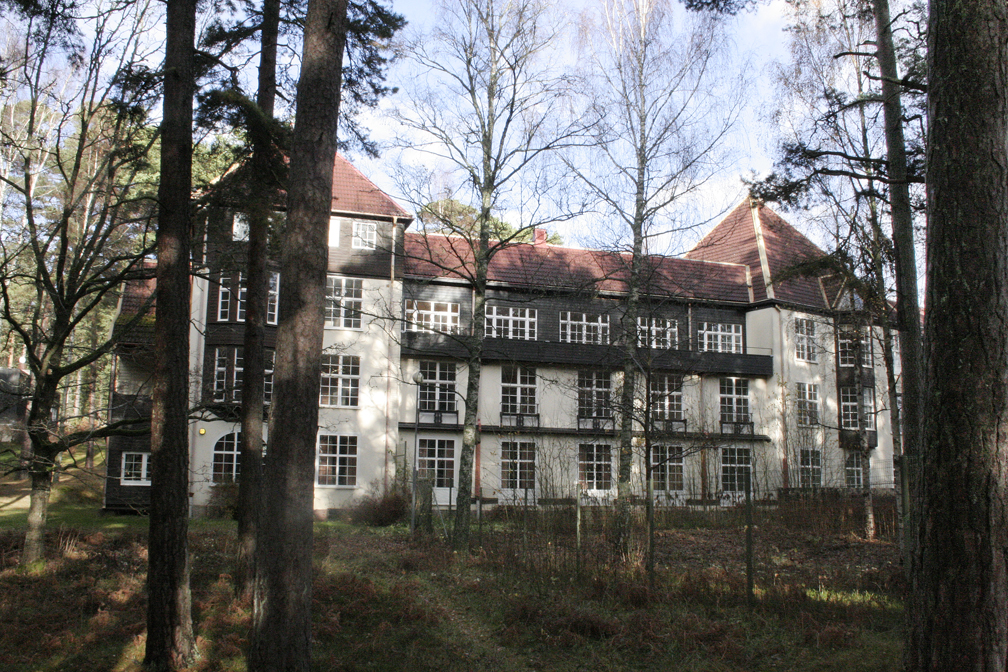 Romanäs sanatorium, fall 2013. Photo: Eva Stenskär
Romanäs sanatorium, fall 2013. Photo: Eva Stenskär -
She stood so close, she took my hand,
she whispered: “Come to me.”
At once I understood and knew –
my only love was she. -
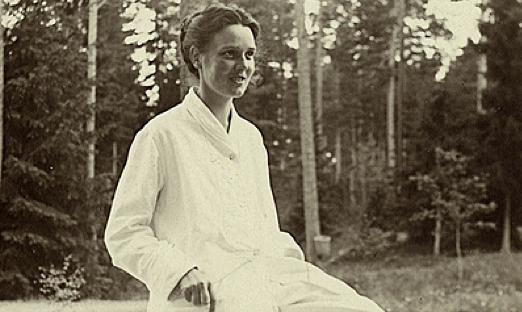 Photo of Harriet Löwenhjelm at Romanäs sanatorium by fellow patient Ulf von Konow, 1917.
Photo of Harriet Löwenhjelm at Romanäs sanatorium by fellow patient Ulf von Konow, 1917. -
We wandered down a linden walk,
I wept and I was sad.
The autumn leaves were wet and sere
and yet my heart was glad. -
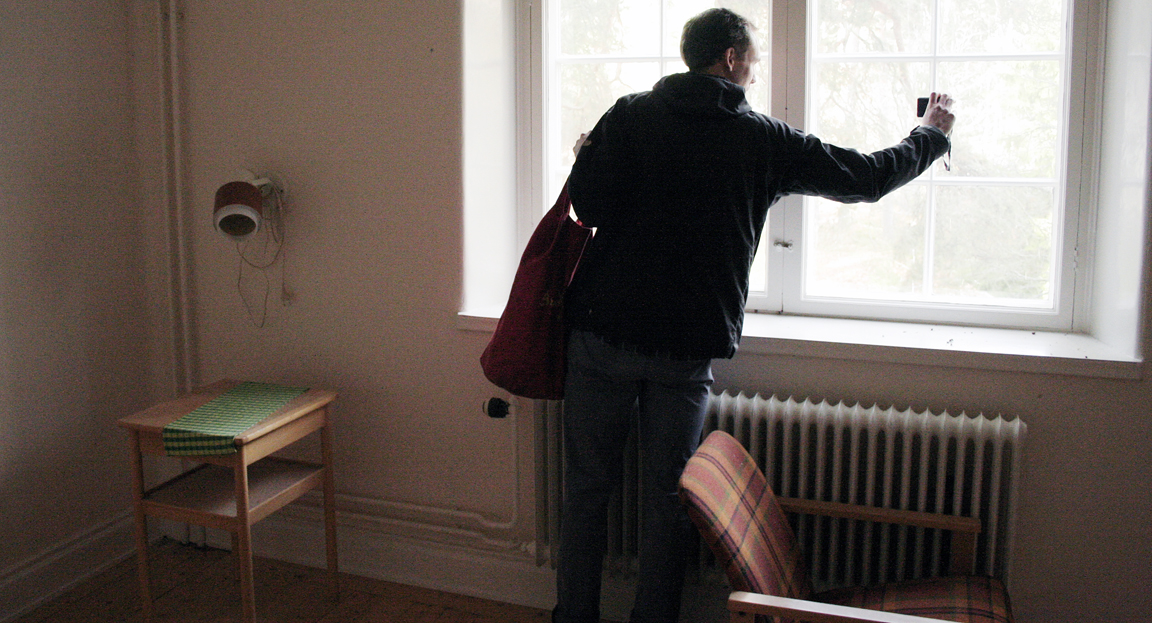
-
We walked and held each other’s hand.
Like children’s were our words.
And then we reached a quaint old mill
with many singing birds. -
I said: “Will you be mine alone,
say, Beatrice-Aurore?”
“Then catch me if you can,” she cried
and left me at the door. -
And I ran in and searched and searched
in every nook around,
and cried – but Beatrice-Aurore
was nowhere to be found. -
I woke up crying bitterly
and in my heart a sting.
And in my dream-book then I searched
but there was not a thing. -
Harriet Löwenhjelm is her name, and the above poem maybe her most famous. Today, she is an otherwise nearly forgotten poet and artist. The place is Romanäs sanatorium, outside Tranås in Sweden, and the photograph was taken by a fellow patient, Ulf von Konow, less than a year before Harriet Löwenhjelm died of tuberculosis in 1918, just 31 years old.
-
The Art of Loving
The troubled American poet Sylvia Plath once said that a poem can go surprisingly far, farther than the words of a classroom teacher or the prescription of a doctor, farther, if lucky, than a lifetime.
I pilfer the magazine with the photo of Harriet Löwenhjelm from the hospital. I take it home, read the article and look at the girl in the photo. The girl about to die. “Beatrice-Aurore” makes me want to know more about her. At the library I discover a new (2011) book, “Att skjuta en dront,” written by Boel Hackman. It jumps around a bit in Harriet’s short life but nevertheless draws a full picture of a girl growing up in an aristocratic family in Stockholm at the turn of the century. Harriet’s artistic talents are discovered early, but there’s nobody around to encourage them. A girl born with a silver spoon of the upper class needs not concern herself with art. There’s also a Peter Pan-like quality in Harriet; a refusal to grow up.
Shunning all responsibilities, she and her brother Crispin play with dolls until she reaches her 20s, but she also reads Kierkegaard and “Arabian Nights.” Her mother, a dominant and complex woman, insists on daily devotions, and imprints on her children a fear of God; but the rest of the Löwenhjelms is a lively bunch, drawn to animated and intellectual discussions and games of all sorts. All they ask of Harriet is that she marries—within her own class, needless to say. But Harriet doesn’t.
Instead, she’s accepted at Konstakademin (the Royal Swedish Academy of Fine Arts), but can’t seem to commit even there. It’s as if she has no real footing in life. Letters and excerpts from her diary show that Harriet is painfully aware of this.
At the Academy, she is constantly late for her lessons and finally expelled. The drawings that she has left all show a great sense of movement, and Harriet might have made an excellent illustrator. She continues drawing and writing poetry, collecting her best poems in a book she calls “Konsten att älska” (The Art of Loving). She tries, unsuccessfully, to find a publisher for it. It’s at this time she is diagnosed with tuberculosis. The diagnosis probably spurs her to publish the book herself: 50 examples of it, in which poems like “Beatrice-Aurore” and “Tallyhoe, tallyhoe, jag har skjutit en dront” are included. -
The girl in the photograph
I want to get back to the girl in the photograph. I wonder what it feels like to sit there on a sunny sanatorium loggia, with all your dreams falling to pieces. What’s it like to be young and pretty and robbed of a future? At first, as has been suggested, Harriet’s disease was probably a bit of relief to her. It meant she didn’t have to make difficult decisions about her artistic future, it meant she could suspend thoughts about getting married and raising a family. It is, by the way, unclear if Harriet was ever really in love, and it seems the only people really close to her, apart from family members, were women friends. Thus, tuberculosis gives her respite, and seems even to have cheered her a bit.
Harriet is convinced she’ll survive. To live—and die—honorably (“honett” is the word Harriet uses), is a motto she has inherited. But here she lies now, in bed at Romanäs sanatorium, and she cannot die. Because if she dies now all her literary production will come to nought. It will be forgotten. On her bedside table are two books with her poems, and since Harriet cannot save herself, she decides to at least save these. She wants Elsa Björkman, her childhood friend, to come. She needs her. Elsa, Harriet knows, will make sure her illustrated poems survive. Elsa is the only one who can help.
The problem is that Elsa is far away. She's in Russia, working as an aid for the Red Cross, when she receives a telegram from the Department of Foreign Affairs:
“MLLE LÖWENHJELM DESIRE A VOIR MLLE BJÖRKMAN AVANT FIN DU MAI” (Miss Löwenhjelm wishes to see Miss Björkman before the end of May). Realizing her friend is on her deathbed, Elsa throws herself on the train back to Sweden; a train filled to the brim with injured prisoners of war. Because of the Civil War in Finland, Elsa has to take a lengthier route home via Germany, and the train pushes through a Europe darkened by the war. Finally, nearly a month later, Elsa arrives at Romanäs. It is the 22nd of May, the most beautiful time of year in Sweden. The sun is shining, the birds are chirping. Tired, worn and dirty, Elsa hurries up the stairs to Harriet’s room. There they are now. Elsa caresses her friend, she smiles, she takes her hand and she cries, even though Harriet tells her to please not cry. Harriet hands her the two hand-written books.
“Here’s my literary production. You may well publish the poems,” Harriet says.
Then they talk. Little by little Elsa understands that she’s been called from Russia for this: to receive Harriet’s poems. To make sure they get published.
The following night, with Elsa’s hand in hers, Harriet dies. -
Romanäs revisited
Mattias Käck is a young librarian, who founded the Harriet Löwenhjelm Society (Harriet Löwenhjelm Sällskapet) in 2010. Käck discovered Harriet Löwenhjelm as a high school student in Tranås, when his class visited Romanäs.
“I read all her diaries and fell in love with how she viewed life,” he says. ”I felt that her way of looking at the world was similar to my own, or perhaps it became my own while I read her diaries. Our relationship deepened. She began her letters with ‘Elskade’ instead of ‘Älskade’ and said she spelled it that way because it seemed more heartfelt.”
It’s a rainy November morning, and Käck is meeting me at Tranås station, to which I arrive much delayed. We go to Käck’s car, and drive straight to Romanäs. As predicted, the road leads up and up, just like in Thomas Mann’s “The Magic Mountain.” The sanatoriums of old were built on high altitudes where the clean air was supposed to heal the patients affected by tuberculosis. It’s an eerie remnant that meets us, up in the pine tree forest by Lake Sommen. Nicknamed “the castle in the forest,” Romanäs sits there, majestic and huge, like an old dame with nothing left to do. It is architect Carl Westman’s masterpiece with different-sized windows, bays and a long “loggia” balcony in the back, on which the patients rested. It reminds me of a giant German hunting lodge. When we get out of the car, there’s a faint smell of resin.
“When she got really sick, she moved up to the top floor,” says Käck as we walk toward the building. “Room 18.”
Käck has warned me that we won’t be able to go inside. Built between 1905-1907, the sanatorium was used for well-to-do TB patients until 1950, after which it became a treatment facility for alcoholics. It has been empty now since 1997, when it was bought by a married couple for six million SEK ($920,000). There’s been a lot of secrecy and speculation surrounding the future of Romanäs in the local media. I spot an older janitor in blue overalls, and after introducing ourselves, Käck asks if it’s possible for him to let us have a peek inside. The janitor shakes his head.
“People come all the time wanting to have a peek inside, because that woman died here.”
“Eva’s come all the way from America …,” Käck points to me.
The janitor lights up.
“The Chicago area perhaps? I have relatives there.”
“She’s come to write an article about Harriet Löwenhjelm.”
“She should come see my steam boat,” says the janitor. “I have a little museum around here. Someone ought to write about that.”
“Sure,” I nod.
The janitor’s name is Lennart Holm, and he gives us the phone number to one of the owners of Romanäs: Björn Karlsson. I call from Käck’s cell phone, but there’s no answer and I tell Holm that.
Käck and I take a walk among the pine trees, walks like this one were prescribed as treatment by the doctors here, so Harriet must have taken hundreds. It’s drizzling. Down by the lake we drink coffee from a thermos Käck has brought, while he shows me the island the patients referred to as “lycksalighetens ö,” the island of bliss. The view is breathtakingly beautiful, Sweden at its absolute prettiest. I take it all in.
We walk back to the sanatorium. I call the owner again, and this time he picks up. I tell him who I am, and that I would like to take a quick peek inside the sanatorium.
“Absolutely not. We can’t have people do that,” he says.
“I’m just interested in Harriet Löwenhjelm, the poet, you know, who died here. I’m writing an article. It wouldn’t take more than five minutes. Please?”
“No, no. A lot of people want to take a look inside, but we’ve made a decision to say no. It doesn’t matter if you’re interested in Harriet Löfgren or not.”
The Löfgren gets to me.
“OK,” I say. “Thank you. Good-bye.”
We hang up. I look at Käck. We’re back at the sanatorium now, and the janitor is still there, tinkering with his tools.
“I spoke to the owner. He gave us green light to enter,” I lie.
Seconds later, Käck and I are let in—chaperoned by Holm. We must promise not to take any photographs.
The insides are in impeccable order and, we gather, pretty much intact and unchanged since Harriet’s days. The style is Art Nouveau, fresh, clean and very light—like a Swedish summer day. I recognize items from vintage photographs of Romanäs. Käck points out details, but we’re both too busy to watch. We’re all eyes. Holm marches ahead. To my astonishment I see fresh flowers in a vase!
“Room 18?” I whisper to Käck.
“They’ve painted over the numbers, so it’s impossible to tell.”
And of course we take photos, loads of them, when Holm doesn’t see. Me with my phone, Käck with his palm-sized camera.
“Maybe here…?”
We peek into room after room, all more or less the same and all with new beds topped with mattresses still in plastic. The hallways are filled with dozens and dozens of bedside tables. Something’s obviously in the plans.
“Maybe here…?”
Then we notice a small, framed plan over the rooms—old and stained and leaning against a wall. We find room 18 on it—a corner room, without direct access to the loggia. Room 18 doesn’t face the back with the beautiful Lake Sommen, it faces the front of the building, with the entrance, a door red as a stigmata.
“Here then?”
There’s a bed in there, just like the beds in the other rooms.
We take photos, until we hear Holm’s footsteps in the corridor outside. -
Am I unto death quite worn,
oh so worn,
quite, quite worn,
sick and worn and lonely.
Long’s the road I’ve trudged forlorn.
No undying love I’ve sworn.
I am worn,
oh so worn,
sick and worn and lonely. -
It is in the shadow of death that Harriet finally lets go of all pretense, at least in her poetry. In poems like “Is that you, is that you my child, dearest of all?” “Am I Unto Death Quite Worn,” and “Take me, hold me” we finally meet her as she is: vulnerable, lonely, sad and sick. Death is inevitable, and Harriet is not going to be able to escape. Gone is the aristocratic girl who wants to live and die “honorably,” off is the mask of courage. Here now is a girl about to die, a girl who barely had begun to live.
Käck and I are having a late lunch in Tranås. He’s brought his extensive collection of photographs of Harriet. He found them in a box at Uppsala Library. Unlisted. He brought the box home, made copies of everything in it, and returned it to the library.
“It probably still sits there,” he says.
We talk about Harriet. Her untimely death, her personality, her humor and her great charm. How fun she must have been to be around! Käck says she might have been engaged to a man named Poulsen, but who can say for sure? We talk about a friend she had at Romanäs, the bizarre Daisy Castenskiold with whom Harriet whipped up a number of pranks, such as roller skating in the basement. We talk about her penchant for beautiful clothes, the yellow boots she wore on her walks at Romanäs. And we talk about her relationship with Elsa. It is thanks to Elsa that Harriet’s poems are published posthumously. It is thanks to Elsa that these poems rise from Harriet’s ashes and form a life of their own.
Harriet’s life and poems are experiencing a revival. Her collected poems were recently re-issued. And not only are her poems read, they are set to music (most Swedes are familiar Hjalmar Casserman’s version of “Beatrice-Aurore”), the composer Gunnar Edander sent me a wonderful CD with his musical interpretations of Harriet’s poems. Harriet’s life has been made into at least two plays: Agneta Elers-Jarleman’s “Harriet L” and another one called “Elsa & Harriet” about the friendship between the two women. I also found a book with English translations of Harriet’s poems by Mike McArthur, called “Harriet Löwenhjelm: Selected Poems.” -
“Take me. Hold me.”
Take me. Hold me. Slowly caressing,
gently enfold me a little while.
Weep a tear for facts depressing,
watch me asleep with tender a smile. -
Oh, do not leave, you do want to stay,
oh, stay here till I myself must depart.
Lay your beloved hand of my forehead –
yet for a little while not apart. -
Tonight I shall die. There flickers a flame.
A friend by my side is holding my hand.
Tonight I shall die. But who knows the name
of where I am going – unto what land? -
Story written by Eva Stenskär
-
“Beatrice-Aurore,” translator unknown
“Am I unto death quite worn,” translated by Anne-Charlotte Harvey
“Take me, hold me,” translated by Anne-Charlotte Harvey
For information about Mike McArthur’s book with translations of Harriet Löwenhjelm’s poems (ISBN: 978-0-9539732-9-3): swedishpoetry@hotmail.com
Harriet Löwenhjelm “Samlade dikter” (ISBN: 918919649X)
Boel Hackman’s biography from 2011, “Att skjuta en dront” (ISBN: 9789100111076)
For information about Gunnar Edander’s music: www.algonet.se/~edander/
For information about the Harriet Löwenhjelm Society: www.harrietlowenhjelm.se
Litteraturbanken has digitalized parts of Harriet Löwenhjelm’s original scripts, which are kept at Kungliga Biblioteket (the Royal Library) in Stockholm. You can look at them here: http://litteraturbanken.se/#!/forfattare/LowenhjelmH/titlar -
-
